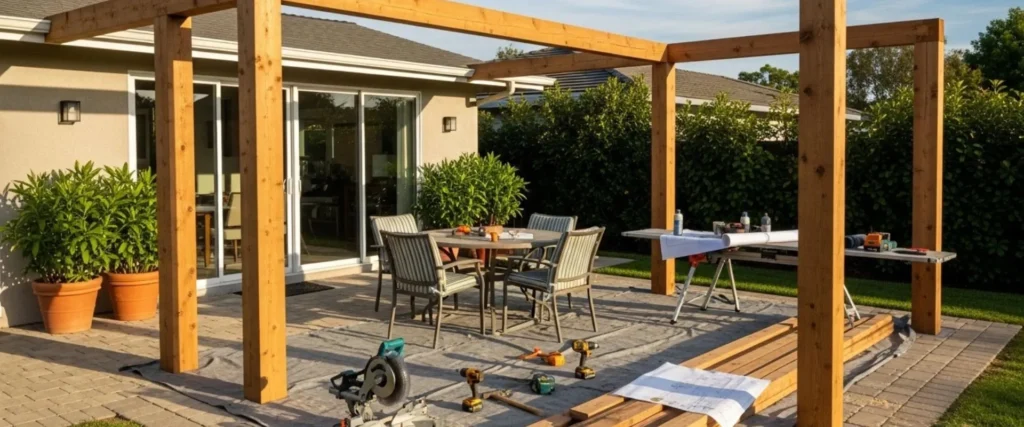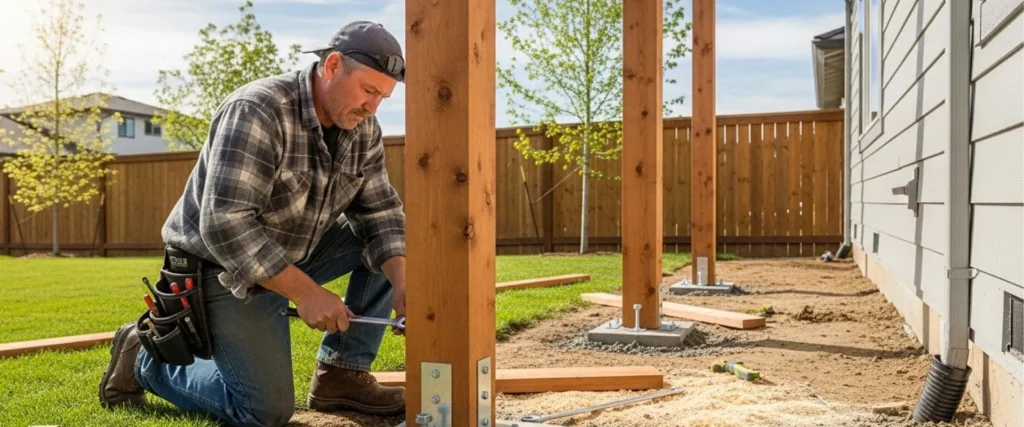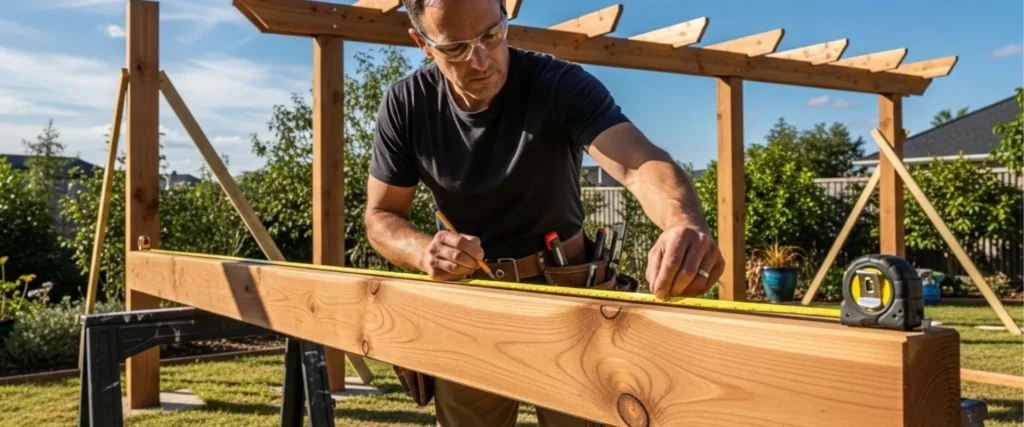Planning to add a pergola to your outdoor space? You’re making a smart choice. Pergolas create beautiful focal points while providing shade and structure to any backyard. However, installing a pergola requires careful planning to ensure you get the most value from your investment.
At Wood Kingdom West, we’ve helped Long Island homeowners transform their backyards for over 35 years. Through our experience, we’ve learned that successful pergola installations depend on thoughtful preparation. This guide covers everything you need to know before installing a pergola, from location selection to budget planning.


Location and Space Requirements
Choosing the right spot for your pergola sets the foundation for everything else. The location affects both functionality and visual appeal.
Measuring Your Available Space
Start by measuring your intended area carefully. Standard pergolas range from 8×8 feet for smaller spaces to 16×20 feet or larger for expansive yards. Consider these spacing guidelines:
- Leave at least 3 feet between your pergola and property lines
- Allow 2-3 feet of clearance from existing structures
- Ensure adequate walking space around all sides
Sun and Shade Patterns
Watch how sunlight moves across your yard throughout the day. Installing a pergola in an area that receives morning sun but afternoon shade creates a comfortable outdoor living space. If your chosen spot gets intense all-day sun, plan for additional shade solutions like retractable canopies or climbing vines.
Proximity to Your Home
Position your pergola where it complements your home’s architecture and outdoor flow. Popular locations include:
- Adjacent to patios or decks for seamless indoor-outdoor transitions
- Over outdoor dining areas or seating zones
- As standalone garden features in larger yards
- Near pools or hot tubs for defined relaxation areas
Permits and Building Codes
Understanding local regulations prevents costly delays and ensures your pergola meets safety standards.
When You Need Permits
Most municipalities require building permits for permanent pergola installations. Generally, you’ll need permits if your pergola:
- Exceeds certain height limits (typically 10-12 feet)
- Covers areas larger than specified square footage
- Includes electrical or plumbing components
- Attaches to existing structures
Setback Requirements
Local zoning laws specify how far structures must sit from property lines. These setback requirements vary by area but typically range from 5 to 10 feet. Check with your local building department before finalizing your pergola placement.
HOA Restrictions
If you live in a homeowners’ association community, review your HOA guidelines. Some associations restrict structure sizes, materials, or colors. Getting HOA approval before installation saves time and potential conflicts.


Foundation and Ground Preparation
Proper foundation work ensures your pergola remains stable and level for years to come.
Ground Conditions Assessment
Evaluate your installation site’s ground conditions. Level, well-draining soil provides the best foundation. Sloped areas may require additional grading or specialized footings. Avoid areas with:
- Poor drainage or standing water
- Underground utilities (call 811 before digging)
- Tree roots that could interfere with footings
- Rock or extremely hard soil without proper equipment
Foundation Options
Different pergola types require different foundation approaches:
- Concrete Footings: Most permanent pergolas need concrete footings extending below the frost line. This typically means digging holes 2-3 feet deep and 12 inches wide for each post.
- Ground Anchors: Some pergola kits use ground anchor systems that don’t require concrete. These work well for temporary installations or areas where concrete isn’t practical.
- Deck Mounting: Pergolas can mount directly to existing decks using specialized hardware, provided the deck structure can support the additional weight.


Material Selection and Durability
Your material choice affects both appearance and maintenance requirements over time.
Wood Options
Wood pergolas offer natural beauty and customization options:
- Cedar: Naturally weather-resistant with attractive grain patterns
- Pressure-treated lumber: Affordable option with good durability
- Hardwoods: Premium choice offering superior longevity
Wood pergolas require regular staining or sealing to maintain appearance and weather resistance.
Low-Maintenance Alternatives
Consider these options if you prefer minimal upkeep:
- Vinyl: Weather-resistant and available in various colors
- Aluminum: Lightweight, rust-resistant, and modern appearance
- Composite materials: Combine wood appearance with synthetic durability
Style Considerations
Match your pergola style to your home’s architecture and your backyard pergola ideas. Popular styles include:
- Traditional designs with decorative end cuts
- Modern minimalist structures with clean lines
- Mediterranean styles featuring curved elements
- Rustic designs using natural wood textures
Utility Line Considerations
Safety requires checking for underground utilities before any digging begins.
1. Call Before You Dig
Contact 811 (or your local utility marking service) at least 2-3 business days before installation. This free service marks underground gas, electric, water, and communication lines.
- Overhead Clearances
Check for overhead power lines, cables, or phone lines that could interfere with your pergola or installation process. Maintain at least 10 feet of clearance from power lines.
Weather and Climate Factors
Your local climate affects both pergola selection and installation timing.
Wind Considerations
High-wind areas require additional bracing and stronger foundations. Consider your region’s typical wind patterns and storm frequencies when planning your installation.
Snow Load Requirements
If you live in areas with heavy snow, your pergola must handle snow loads. This typically means:
- Stronger beam construction
- Reduced spacing between support elements
- Engineered designs for extreme loads
Seasonal Installation Timing
Plan installation during favorable weather conditions. Spring through early fall typically offers the best conditions for concrete work and construction.


Why Choose Professional Installation
While DIY installation saves money upfront, professional installation offers significant advantages.
1. Expertise and Experience
Professional installers bring years of experience handling different soil conditions, site challenges, and local building codes. They can identify potential problems before they become expensive issues.
2. Quality Assurance
Professional installations typically include warranties covering both materials and workmanship. This protection gives you peace of mind about your investment.
3. Time Savings
Professional teams complete installations much faster than DIY approaches, often finishing in 1-2 days versus several weekends for homeowner installations.
At Wood Kingdom West, our experienced team handles every aspect of pergola installation, from permits to final finishing touches. We’ve been creating beautiful Long Island backyards since 1989 and understand local conditions and requirements.
Transform Your Backyard Today
Installing a pergola creates lasting value and enjoyment for your outdoor space. Following expert pergola installation tips ensures your pergola provides years of beauty and functionality while avoiding common pitfalls.
Ready to start your pergola project? Contact Wood Kingdom West today to discuss your pergola installation needs. Our experienced team will help you choose the perfect pergola for your space and handle every detail from planning to completion.
Frequently Asked Questions
How long does pergola installation typically take?
Professional installation usually takes 1-2 days for standard pergolas, though complex custom designs or challenging site conditions may require additional time.
Can I install a pergola on my existing deck?
Yes, pergolas can be mounted to existing decks if the deck structure can support the additional weight. Professional evaluation ensures safe installation.
What’s the best material for Long Island’s climate?
Cedar and pressure-treated lumber work well in Long Island’s climate, though vinyl and aluminum options require less maintenance over time.
Do I need a permit for a 10×10 pergola?
Permit requirements vary by municipality. Most areas require permits for permanent structures, regardless of size. Check with your local building department.
How much maintenance does a wood pergola require?
Wood pergolas typically need staining or sealing every 2-3 years to maintain appearance and weather resistance.

